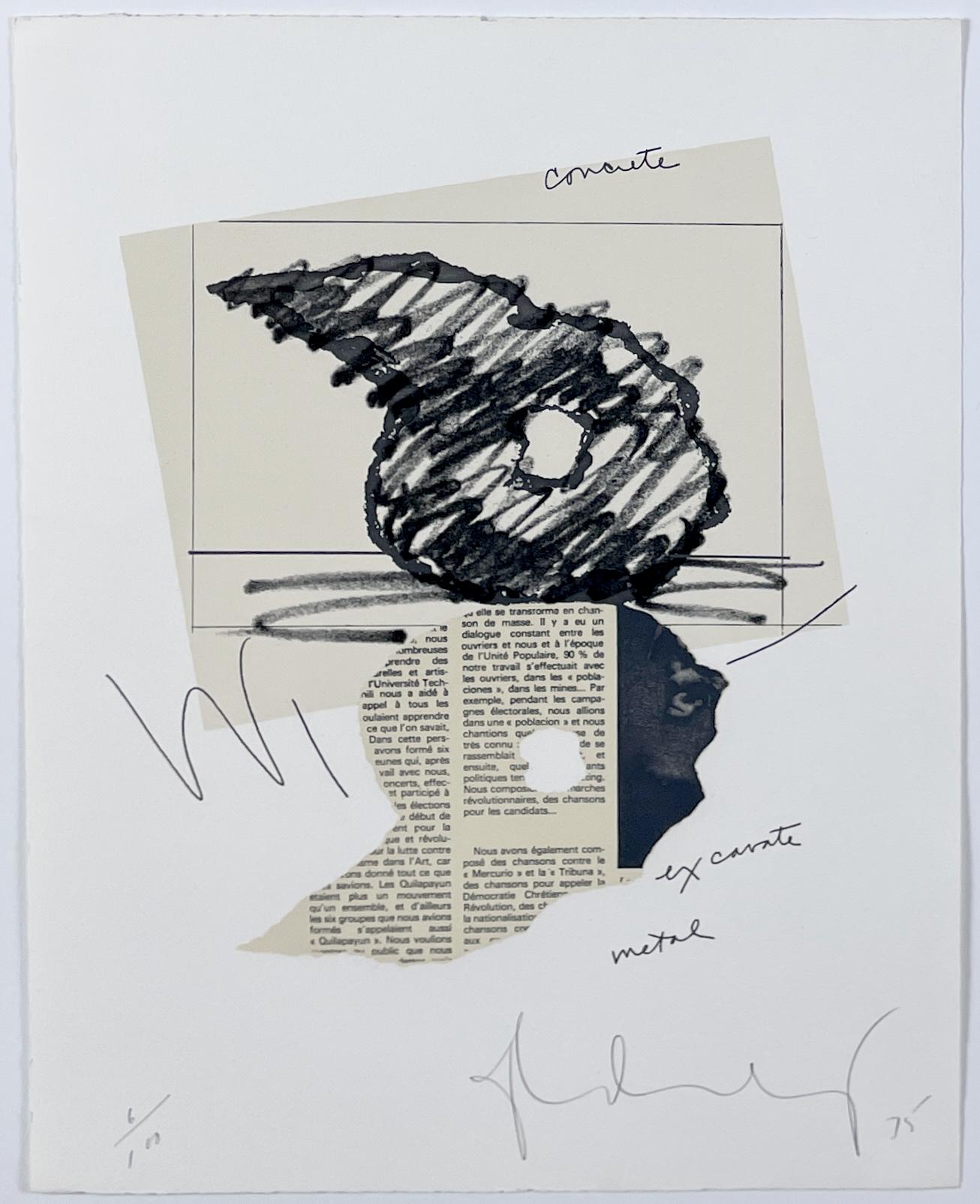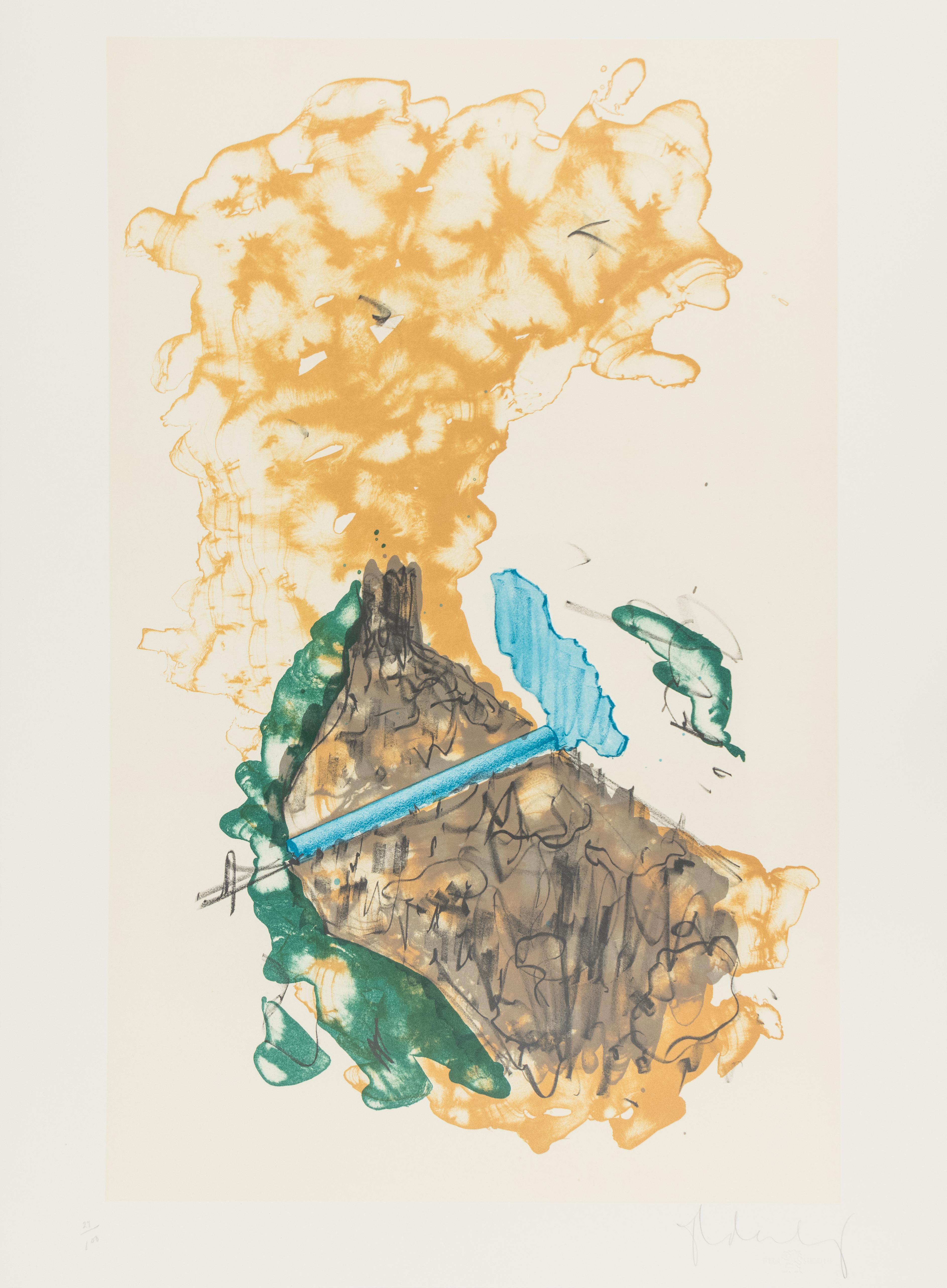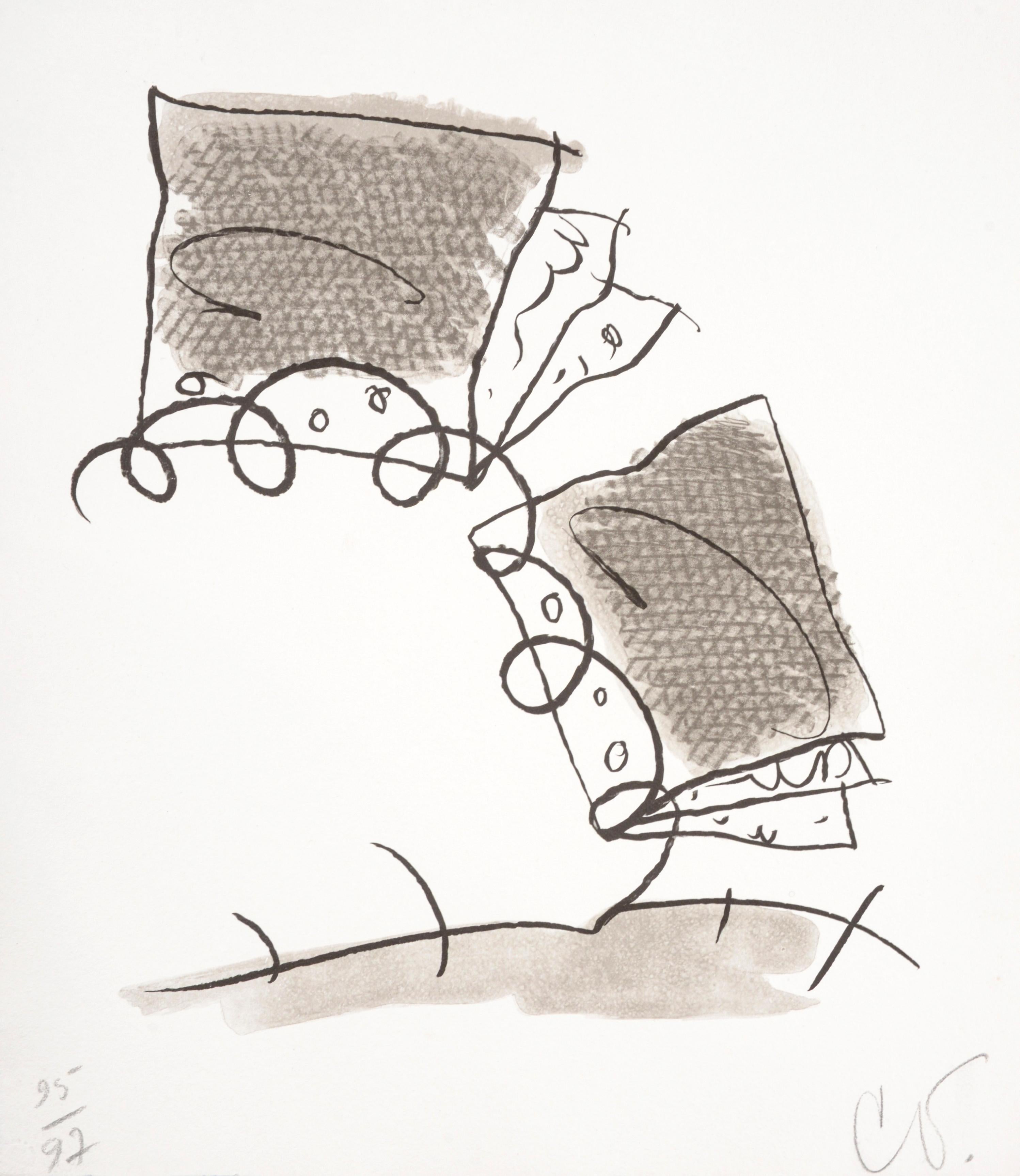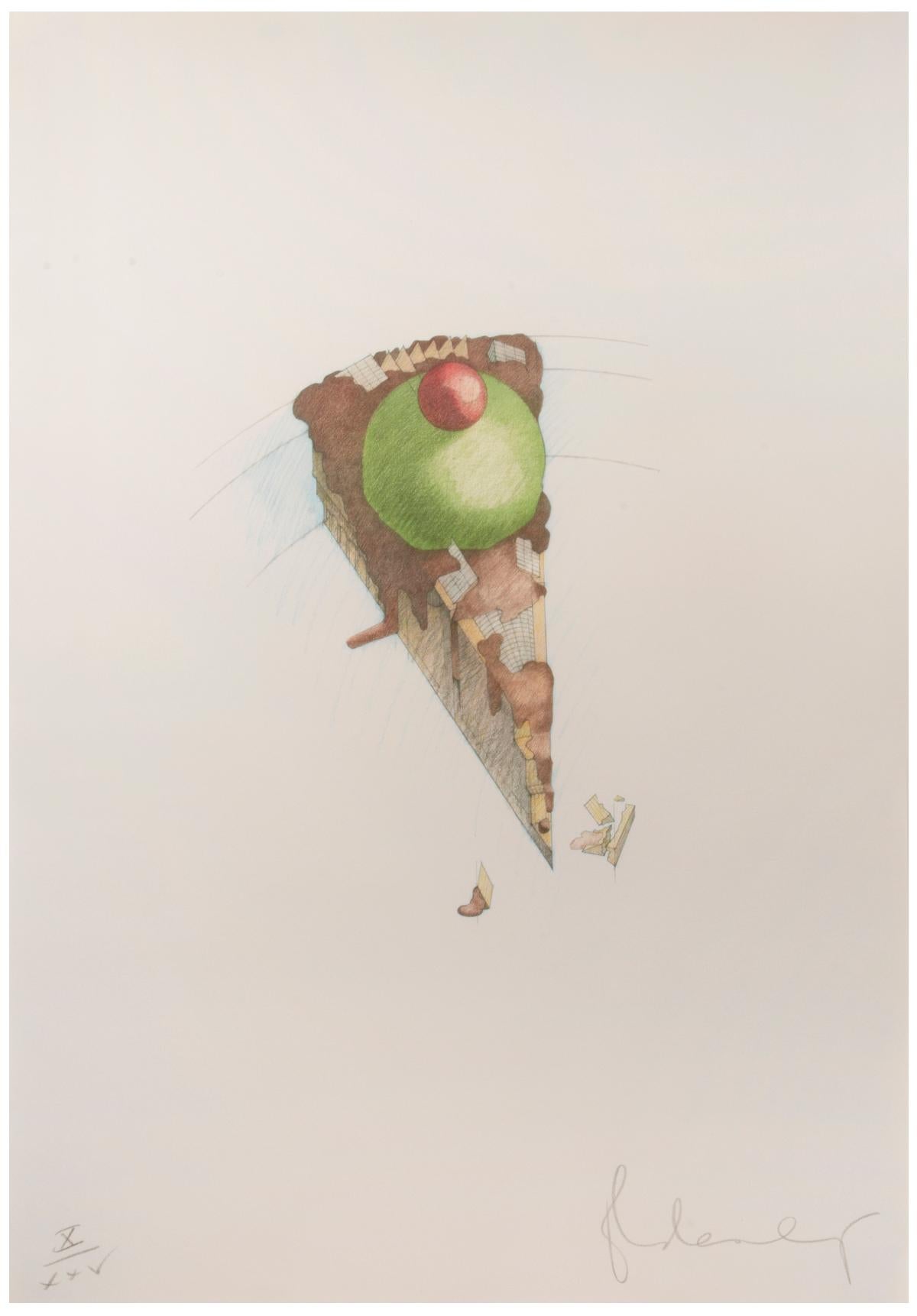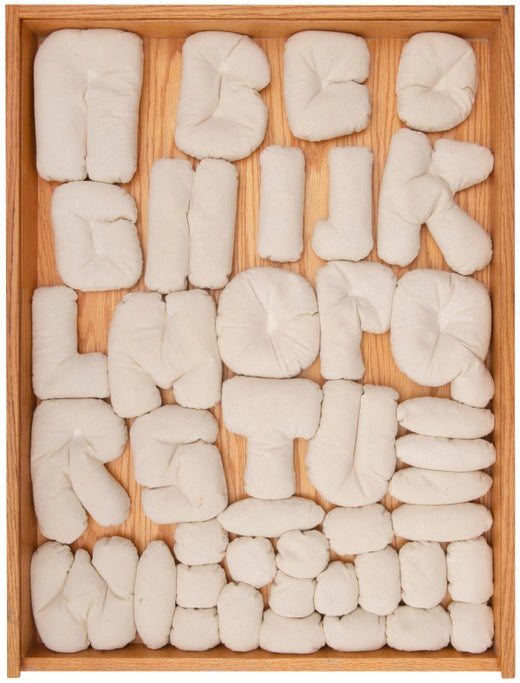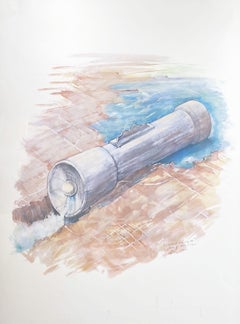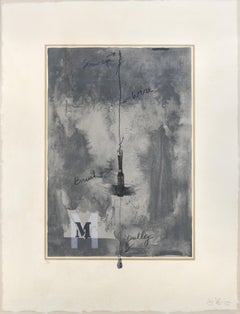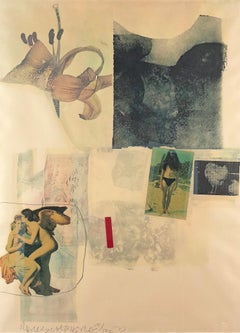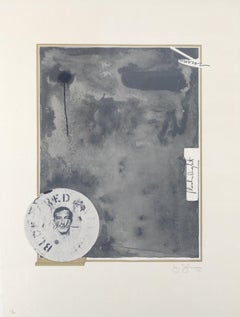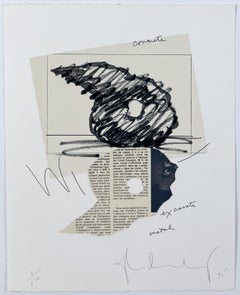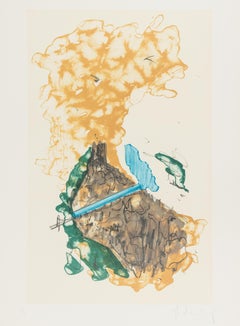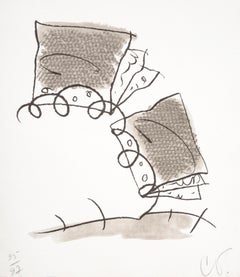Pickaxe (Spitzhacke) Superimposed on a Drawing of the Site by E.L. Grimm, 1982
By Claes Oldenburg (Swedish, American, 1929-2022)
Unframed: 26" x 20"
Framed: 28.75" x 22.75"
Signed and Dated Lower Right
Whimsical sculpture of pop culture objects, many of them large and out-of-doors, is the signature work of Swedish-born Claes Oldenburg who became one of America's leading Pop Artists. He was born in Stockholm, Sweden. His father was a diplomat, and during Claes' childhood moved his family from Stockholm to a variety of locations including Chicago where the father was general consul of Sweden and where Oldenburg spent most of his childhood. He attended the Latin School of Chicago, and then Yale University where he studied literature and art history, graduating in 1950, the same year Claes became an American citizen.
Returning to Chicago, he enrolled at the Art Institute of Chicago from 1952 to 1954 and also worked as a reporter at the City News Bureau. He opened his own studio, and in 1953, some of his satirical drawings were included in his first group show at the Club St. Elmo, Chicago. He also painted at the Oxbow School of Painting in Michigan.
In 1956, he moved to New York where he drew and painted while working as a clerk in the art libraries of Cooper-Union Museum for the Arts of Decoration. Selling his first artworks during this time, he earned 25 dollars for five pieces.
Oldenburg became friends with numerous artists including Jim Dine, Red Grooms and Allan Kaprow, who with his "Happenings" was especially influential on Oldenburg's interest in environmental art. Another growing interest was soft sculpture, and in 1957, he created a piece later titled Sausage, a free-hanging woman's stocking stuffed with newspaper.
In 1959, he had his first one-man show, held at the Judson Gallery at Washington Square. He exhibited wood and newspaper sculpture and painted papier-mache objects. Some viewers of the exhibit commented how refreshing Oldenburg's pieces were in contrast to the Abstract Expressionism, a style which much dominated the art world. During this time, he was influenced by the whimsical work of French artist, Bernard Buffet, and he experimented with materials and images of the junk-filled streets of New York.
In 1960, Oldenburg created his first Pop-Art Environments and Happenings in a mock store full of plaster objects. He also did Performances with a cast of colleagues including artists Lucas Samaras, Tom Wesselman, Carolee Schneemann, Oyvind Fahlstrom and Richard Artschwager, dealer Annina Nosei, critic Barbara Rose, and screenwriter Rudy Wurlitzer.
His first wife (1960-1970) Pat Muschinski, who sewed many of his early soft sculptures, was a constant performer in his Happenings. This brash, often humorous, approach to art was at great odds with the prevailing sensibility that, by its nature, art dealt with "profound" expressions or ideas.
In December 1961, he rented a store on Manhattan's Lower East Side to house "The Store," a month-long installation he had first presented at the Martha Jackson Gallery in New York. This installation was stocked with sculptures roughly in the form of consumer goods.
Oldenburg moved to Los Angeles in 1963 "because it was the most opposite thing to New York I could think of". That same year, he conceived AUT OBO DYS, performed in the parking lot of the American Institute of Aeronautics and Astronautics in December 1963.
In 1965 he turned his attention to drawings and projects for imaginary outdoor monuments. Initially these monuments took the form of small collages such as a crayon image of a fat, fuzzy teddy bear looming over the grassy fields of New York's Central Park (1965) and Lipsticks in Piccadilly Circus, London (1966). Oldenburg realized his first outdoor public monument in 1967; Placid Civic Monument took the form of a Conceptual performance/action behind the Metropolitan Museum of Art, New York, with a crew of gravediggers digging a 6-by-3-foot rectangular hole in the ground.
Many of Oldenburg's large-scale sculptures of mundane objects elicited public ridicule before being embraced as whimsical, insightful, and fun additions to public outdoor art. From the early 1970s Oldenburg concentrated almost exclusively on public commissions.
Between 1969 and 1977 Oldenburg had been in a relationship with Hannah Wilke, feminist artist, but in 1977 he married Coosje van Bruggen, a Dutch-American writer and art historian who became collaborator with him on his artwork. He had met her in 1970, when she curated an exhibition for him at the Stedelijk Museum in Amsterdam. Their first collaboration came when Oldenburg was commissioned to rework Trowel I, a 1971 sculpture of an oversize garden tool, for the grounds of the Kröller-Müller Museum in Otterlo, the Netherlands.
Oldenburg has officially signed all the work he has done since 1981 with both his own name and van Bruggen's. In 1988, the two created the iconic Spoonbridge and Cherry sculpture for the Walker Art Center in Minneapolis, Minnesota that remains a staple of the Minneapolis Sculpture Garden as well as a classic image of the city. Typewriter Eraser, Scale X (1999) is in the National Gallery of Art Sculpture Garden. Another well known construction is Free Stamp in downtown Cleveland, Ohio.
In 1992 Oldenburg and van Bruggen acquired Château de la Borde, a small Loire Valley chateau, whose music room gave them the idea of making a domestically sized collection. Van Bruggen and Oldenburg renovated the house, decorating it with modernist pieces by Le Corbusier, Charles and Ray Eames, Alvar Aalto, Frank Gehry, Eileen Gray.
In addition to freestanding projects, they occasionally contributed to architectural projects, among them two Los Angeles projects in collaboration with architect Frank O. Gehry: Toppling Ladder With Spilling Paint, which was installed at Loyola Law School in 1986, and Binoculars, Chiat/Day Building, completed in Venice in 199. The couple's collaboration with Gehry also involved a return to performance for Oldenburg when the trio presented Il Corso del Coltello, in Venice, Italy, in 1985. In 2001, Oldenburg and van Bruggen created Dropped Cone, a huge inverted ice cream cone, on top of a shopping center in Cologne, Germany. In 2011, The Pennsylvania Academy of the Fine Arts acquired Paint Torch, a towering 53-foot-high pop sculpture of a paintbrush, capped with bristles that are illuminated at night. The sculpture is installed at a daring 60-degree angle, as if in the act of painting.
Van Bruggen died on January 10, 2009, from the effects of breast cancer.
Special Recognition:
In 1989, Oldenburg won the Wolf Prize in Arts. In 2000, he was awarded the National Medal of Arts. Oldenburg has also received honorary degrees from Oberlin College, Ohio, in 1970; Art Institute of Chicago, Illinois, in 1979; Bard College, New York, in 1995; and Royal College of Art, London, in 1996, as well as the following awards: Brandeis University Sculpture Award, 1971; Skowhegan Medal for Sculpture, 1972; Art Institute of Chicago, First Prize Sculpture Award, 72nd American Exhibition, 1976; Medal, American Institute of Architects, 1977; Wilhelm-Lehmbruck Prize for Sculpture, Duisburg, Germany, 1981; Brandeis University Creative Arts Award for Lifetime Artistic Achievement, The Jack I. and Lillian Poses Medal for Sculpture, 1993; Rolf Schock Foundation Prize, Stockholm, Sweden, 1995. He is a member of the American Academy and Institute of Arts and Letters since 1975 and the American Academy of Arts and Sciences since 1978.
Oldenburg and Coosje van Bruggen have together received honorary degrees from California College of the Arts, San Francisco, California, in 1996; University of Teesside, Middlesbrough, England, in 1999; Nova Scotia College of Art and Design, Halifax, Nova Scotia, in 2005; the College for Creative Studies in Detroit, Michigan, in 2005, and the Pennsylvania Academy of Fine Arts, 2011. Awards of their collaboration include the Distinction in Sculpture, SculptureCenter, New York (1994); Nathaniel S. Saltonstall Award, Institute of Contemporary Art, Boston (1996); Partners in Education Award, Solomon R. Guggenheim Museum, New York (2002); and Medal Award, School of the Museum of Fine Arts, Boston (2004).
